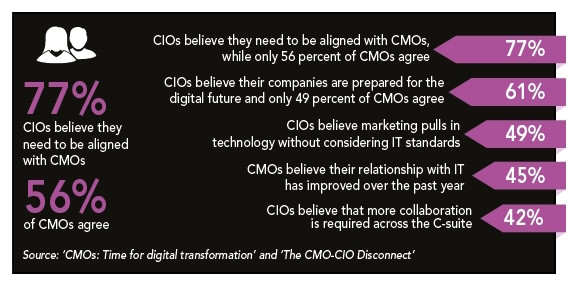
Once upon a time, there was just the CEO, leading the business into the future. Then came the rest of the Cs - CIO, CMO, CFO - named C-suite, where big decisions were made and leaders forged. Today, the C-suite could be inviting a new member to join their illustrious ranks, one who has been developed to cope with the digital economy and the customer-centric marketplace - the Chief Marketing and Information Officer (CMIO). Could this hybrid child of the CIO and CMO, two roles that once sat in separate silos and were tentative bedfellows at best, be what is needed to get the enterprise back into the consumer's pockets through the power of technology?
A digital strategy
It's unlikely, but there's definitely a need for more collaboration between the two silos going forward.
"The CMO is the custodian of the customer in today's modern organisation and is the best person to drive and influence the digital relationship the organisation has with the customer," says Jeremy Swartz, regional director, MEA, Thunderhead.com. "CIOs need to be able to support their organisation with technology that manages and absorbs the massive variables that can be used by the customer to interact with the business."
Accenture recently released a report, CMOs: Time for digital transformation, that surveyed key marketing decision-makers from across the globe. It showed that the IT and marketing departments are under pressure to deliver relevant and integrated customer experiences that inspire engagement with the enterprise.
"The shift has gone from a back-office transformation to a transformation of the consumer experience," says Lee Naik, MD: Technology Strategy at Accenture. "Based on the survey, over 21% of CMOs believed they wouldn't be ready to rise to the digital challenge over the next five years and that their businesses would not be truly digital."
Having a well-defined and structured digital strategy isn't just there to 'keep marketing happy on Twitter', it's become the key to success or failure in a mercurial market. Customers aren't loyal, they want service, reliability and engagement and they don't care who provides it. The CMO and CIO have the opportunity to work towards building a digital strategy that can differentiate their offering in the market, drive growth and add some tasty rands to that all-important bottom line.
For many, there is the assumption that the South African enterprise is lagging behind its international counterparts. This isn't true. The local CIO is aware of the digital economy and the need to tap into it.
"In South Africa, I've found that many CIOs are still plagued by the challenges of their current IT organisation, struggling with the legacy of old infrastructure and the fact that they're seen by the business and the CMO as an IT shop that just delivers on IT," says Naik.
In its report The CMO-CIO Disconnect, Accenture highlights five elements that could align the CMO and the CIO - perhaps finally finding that missing DNA strand that creates the CMIO. These are: identify the CMO as the chief experience officer; accept IT as a strategic partner with marketing and not just a platform provider; agree on key business levers for this alignment such as customer data versus privacy and security; change the skills mix to ensure both silos are marketingand tech-savvy; and develop trust.
Lee-Anne van Zyle, CEO of FNB Online, points out that the next five years are critical for digital transformation in the business, but she doesn't believe that the CIO and CMO will evolve into a single executive role: "The roles have different skills sets and I cannot see them merging in the near future as the complexity of the CIO role extends beyond development and encapsulates testing, systems analysis and ownership of the infrastructure."
"Digital transformation is more than an IT project," adds Patrick O'Reilly, CIO of MIP Holdings. "The CIO often has deep insight into the challenges of other parts of the business and may bring a well-grounded perspective. The CMO can look at what the future will bring to the business and provide insight that is useful to the CIO. What the business needs is a CMO and a CIO who know their own roles, but also know how to work together."

This article was first published in Brainstorm magazine. Click here to read the complete article at the Brainstorm website.
Share